Table of Contents
What is the Foundation?
A structure is generally considered to have two main portions:
- Superstructure
- Substructure
The substructure transmits loads of super-structure to the supporting soil and is generally, termed as the foundation.
The load of the superstructure is transmitted to the foundation or substructure through either columns or walls.
The purpose of providing a foundation to a structure is to distribute the load to the soil in such a way that the maximum pressure on the soil does not exceed its permissible bearing value and at the same time settlement is within the permissible limit.
What is Footing?
The footing is the portion of the foundation which ultimately delivers the load to the soil, and is thus in contact with it.
Types of Foundations and Types of Footings
Foundations may be broadly classified under two heads:
- Shallow Foundation
- Deep Foundation
According to Terzaghi, a foundation is shallow if its depth is equal to or less than its width. The shallow foundations are of the following types:
- Spread or Isolated Footing Foundation
- Strip Footing
- Combined Footing Foundation
- Strap or Cantilever Footing Foundation
- Mat or Raft Foundation
- Grillage Foundation
In the case of the deep Foundation, the depth is greater than the width. Apart from deep strip, rectangular or square foundations other common forms of the deep foundation are:
- Pier Foundation
- Pile Foundation
- Well Foundation
Shallow Foundation
Spread or Isolated footing foundation
A spread footing or simply footing is a type of shallow foundation used to transmit a load of an isolated column or that of a wall, on the subsoil. In the case of the wall, the footing is continuous while in the case of the column, it is isolated.


Strip Footing
It is generally provided for load-bearing walls or rows of columns that are closely spaced. It is also known as wall footing or continuous footing.

Combined footing Foundation
A footing that supports two or more columns is termed a combined footing. Such footing is provided when the individual footings are either very near to each other, or overlap. Combined footing may either be rectangular or trapezoidal.

Strap or cantilever footing Foundation
A strap footing consists of spread footing of two columns by a strap beam. The strap beam does not have any contact with soil and thus does not transfer any pressure to the soil.
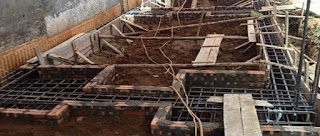
Such footing is generally used to combine the footing of the outer column to the adjacent one so that the footing of the former does not extend in the adjoining property.
Also, Read – Plum Concrete – Purpose, Ratio, Specification and Uses
Mat or Raft Foundation
Raft foundation is very useful when the load coming on the soil is practically uniform while the soil is soft clay or reclaimed soil.
The method consists of providing an RCC slab of suitable thickness and with necessary reinforcement.
The raft is designed in a way that the allowable bearing power of the soil is not exceeded. If required slab and beam construction in RCC can also be carried out.
The raft is designed as an inverted RCC roof with a uniformly distributed load of soil pressure and supported by walls, beams and columns.
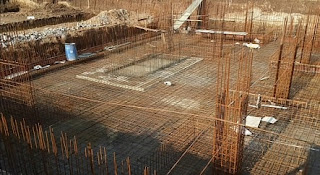
If more than 50% of the plan area of a building gets covered by the combined plan areas of all the individual or combined footing, that needed to be provided.
It is usually more economical to make a mat or raft. A raft is structurally rigid and when it settles, settle uniformly as a monolithic entity.
Grillage Foundation
This type of foundation consists of steel or wooden joints arranged in a stepped manner. It distributes the load over a large area.
A trench 90cm to 150 cm deep is excavated and levelled. Then a layer of 23cm to 30 cm of cement concrete 1:2:4 or 1:1.5:3 is spread and compacted.
Over this concrete steel, I-beams are laid and are placed at s suitable intervals of 45 to 90 cm. The length of these I-beam is equal to the width of the foundation.
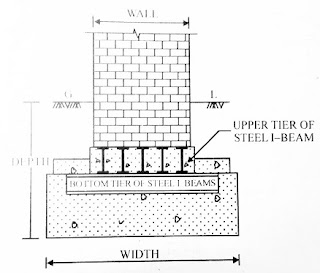
The space between the I beams is filled with cement concrete. Over these, the second layer of I-beams is placed at a right angle to the first layer.
Again the internal space is filled with cement concrete. the wall is built directly over the grillage bed.
This type of foundation is used for heavy buildings such as factories, town halls and towers.
Also, Read – What is BOQ? – Purpose, Importance, Advantages and Disadvantages
Deep Foundation
Pile foundation
A Pile foundation is a deep foundation used where the topsoil is relatively weak. Piles transfer the load to a lower stratum of greater bearing capacity by way of end bearing or to the intermediate soil through skin friction.

This is the most common type of deep foundation generally used for buildings where a group of piles transfer the load of the superstructure to the sub-soil.
Well foundation
This type of foundation is usually adopted in the construction of the bridge and long span culverts or where the soil or quite soft and sandy generally in water. Well foundations are made of masonry or concrete.
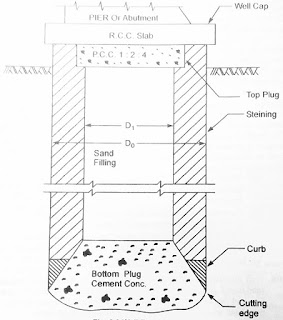
Pier Foundation
Pier foundation is a type of deep foundation which consist of a cylindrical column of large diameter to support and transfer large superimposed loads to firm strata below.
Pier is inserted down to the bedrock. Pier has a footing. Pier is typically dug out and cast in place using formwork. There are two types of pier foundation:
- Masonry or Concrete Pier
- Drilled Cassion
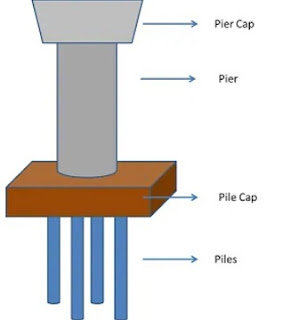
Conclusion
So friends these are the types of foundation and footing which are used in construction.
I have tried to cover all the information about Types of Foundations & Footing And Their Uses in this article.
If you find this information helpful, please share it.
Thanks!
Also, Read
Difference Between One Way and Two Way Slab
Difference Between Plinth Level, Sill Level and Lintel Level
How to Calculate Cement, Sand and Aggregate in Concrete?
Difference Between Pre Tensioning and Post Tensioning
What is Lap Length? How to Calculate It? – Complete Guide
What is Development Length? – Complete Guide
Its like you read my thoughts! You seem to grasp
so much about this, like you wrote the e-book in it or
something. I believe that you simply can do with some percent to pressure the message house a bit, however instead of that, that is great blog.
A great read. I will definitely be back.
This website was… how do I say it? Relevant!!
Finally I have found something that helped me. Kudos!
After looking into a few of the blog articles on your
site, I honestly appreciate your technique of
blogging. I saved it to my bookmark site list and will be checking back soon. Please
check out my web site too and tell me how you
feel.
very well written article. I am searching for these types of topics to read for a long time.